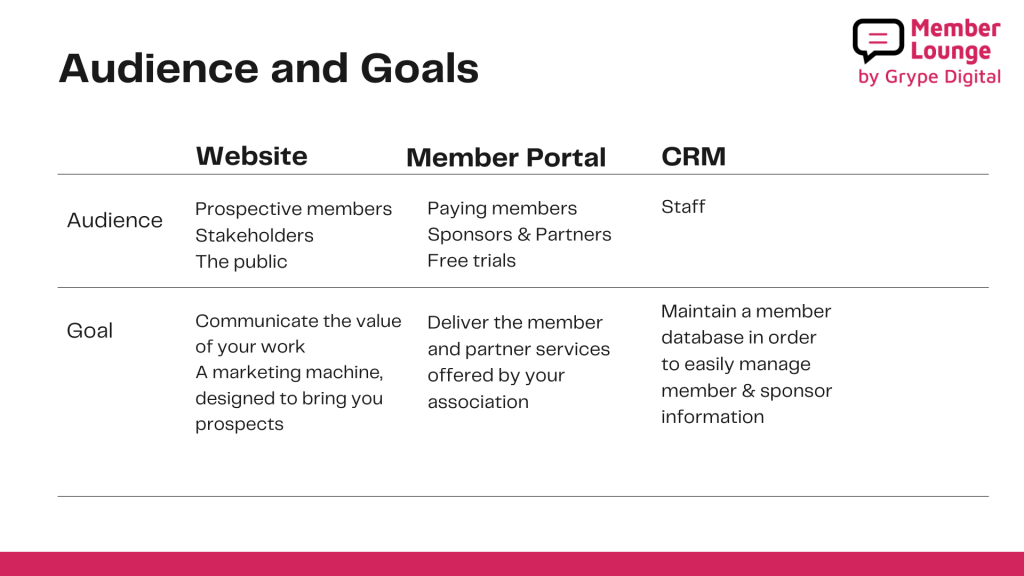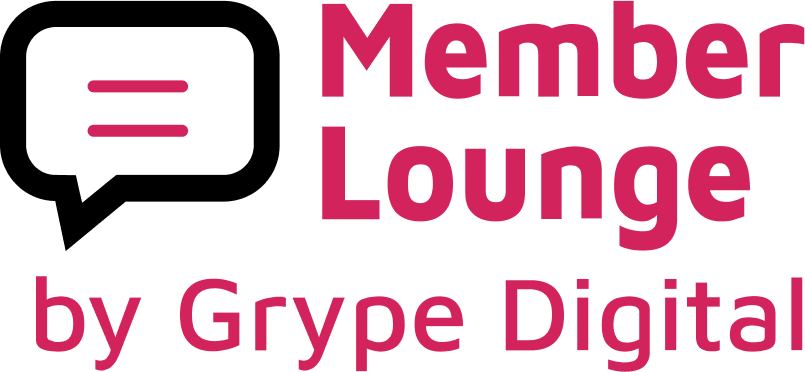Are you looking to build a membership website that effectively communicates the value of your organization, provides efficient member services, and helps you manage member data efficiently?
We use CiviCRM to create a 3 part Membership platform solution for our clients that has every feature, resource, and tool to help you build a thriving community.

What is a 3-part Membership Website:
A 3 part Membership website is a complete membership system that includes a public-facing website, a member portal, and a CRM to manage member information.
Because of the complex needs and sensitive data used by associations, WordPress or Drupal is the CMS we recommend to create a high-performing, long-lasting, and secure membership website.
Then we recommend CiviCRM as the most robust CRM because it provides a comprehensive set of tools for managing memberships, sponsorship, and events for non-profit organizations. Given the extent of API in CiviCRM and the customizations you can make, it can integrate with any other enterprise tool in your organization.
Check out 6 ways CiviCRM Helps Your Business Grow
In this article, we’ll explore the benefits of each part of the 3 part membership sites we build for associations, how they are connected, and why you need to have a 3 part membership website solution.
Part 1: The Website
Your website serves as the face of your organization, communicating your values, mission, and accomplishments to the public and prospective members.
Your website is very important as it is the first point of contact for most people, and therefore it’s essential to make a strong first impression here.
Here are some tips to make this part of your membership website effective and help you engage the most:
- Use a clean and easy-to-use website template:
CiviCRM provides a range of website templates that you can use to build a professional-looking website without the need for extensive coding skills.
- Provide clear and concise information about your organization:
Use simple language to explain who you are, what you do, and why it matters. Highlight your achievements and the impact you’ve had on the community.
- Use engaging visuals:
Use images and videos to tell a story and capture the attention of your audience. Use high-quality images that are relevant to your organization and its activities.
- Make it easy for people to contact you:
Provide clear contact information, such as an email address or phone number, and make it easy for people to contact you.
Your website acts as a marketing tool to attract prospects. It’s a crucial component of the three parts necessary to establish a successful membership website portal. These three elements are crucial for onboarding, engagement, and retention strategies.
Part 2: Member Portal
Whatever audience you are serving is special to you and you’ll want to give them what’s best while creating a thriving community for them.
The member portal is an exclusive area of the website. It’s accessible only to paying members, your special audience, through a unique login.
With Member Lounge, (A 3 – part Membership website solution we create for our clients), the member area provides members with exclusive content and services, such as access to member-only events, resources, library, job discussion boards, etc..
Here are some tips for building an effective member portal aimed at member engagement, growth, and retention that we used for Member Lounge:
- Create a membership sign-up process:
You should create a membership sign-up process that is easy to use and requires minimal effort from members.
- Provide exclusive content and services:
Your offers and content should be members exclusive, and something anyone can not just access on the internet. This could include access to member-only events, resources, and discounts.
- Make it easy for members to manage their accounts:
Provide members with an easy-to-use interface where they can update their personal information, renew their membership, and view their payment history. The easier your members can navigate your member’s area, the better your chances of member retention.
- Personalize the member experience:
Provide target content and services based on your member’s interests and preferences, which you would already know through your market research and interactions. This would help you build a better community as members would get the feeling that you understand their pain points.
Part 3: CRM
The CRM is the backbone of the membership website, providing a centralized database for managing member information. It allows staff to easily manage member information, track interactions, and communicate with members.
Here are a few of the reasons why we use CiviCRM to create our 3 part Membership website solution (Member Lounge)
- It is highly customizable, and you can create as many content types as you can think of
- It boasts easy data recording, centralized data storage, and multilingual association support.
- Easily helps you track communication with its dedicated activity feature, and also allows you to create a custom activity with custom data fields
- It is open source and highly secure.
Here are some tips for using CiviCRM effectively as a CRM to achieve member retention and growth:
- Managing member information:
Use CiviCRM to create a member database that contains all relevant member information, such as personal information, membership status, and payment history.
- Track member interactions:
Use CiviCRM to track member interactions, such as emails, phone calls, and event attendance. This information can be used to personalize the member experience and improve member engagement.
- Reports and analyzing data:
Use CiviCRM reports to analyze member data, such as membership sign-ups and renewals, and identify trends and patterns that can inform decision-making.
- Integrate CiviCRM with other tools:
Use CiviCRM to integrate with other tools, such as email marketing platforms and social media, to improve member communication and engagement.
How Are They Connected

The three parts of the membership website – the public-facing website, the member portal, and the CRM – are interconnected and work together as the perfect solution to achieve your membership goals.
The public-facing website serves as the primary point of contact between your organization and prospective members. It provides information about your organization, communicates its value, and encourages people to join.
When a person becomes a member, they can log in to the member portal. Here, they can access the services and resources offered by your organization.
The member portal is designed to be user-friendly and customizable. This design allows you to tailor the experience to the needs and preferences of your members.
Behind the scenes, the CRM stores and manages all member information. It enables your staff to easily track membership status, process payments, and communicate with members.
The CRM offers insights into member behavior, preferences, and engagement levels. This data can inform your organization’s strategies and decision-making.
Connecting these three parts of the membership website creates a cohesive and streamlined experience for members. This improved experience can enhance engagement and retention rates.
Why You Need A 3 Part Membership Website Solution
A 3 part Membership website ultimately serves every audience that an association has in its complete membership journey.
It provides a system that meets your audience at every step of the customer journey and helps solve their problem while moving them up to the next stage of your customer journey.
Here is how A 3 part membership website solution helps your audience:
1. The Prospective audience, stakeholders, and the public(The Website):
This is often the initial point of contact people have with your association. They are eager to learn more about you at this stage. It’s crucial that they experience a unique and seamless journey here, fostering engagement and propelling them to the next stage.
2. Your Paying Members(Member Portal):
Your member portal offers you the means to assist your unique audience. It allows you to provide them with the best possible exclusive experience. Additionally, it helps in building a thriving community.
3. Staff (CRM):
Maintaining the entire platform is a distinct task. Your CRM acts as a database, allowing your team to manage, track, and maintain data easily.





